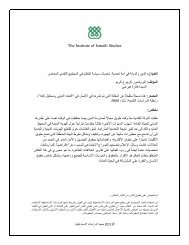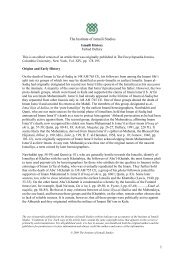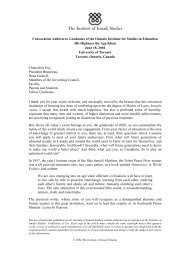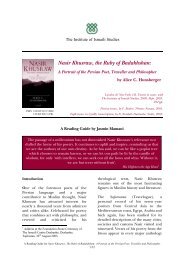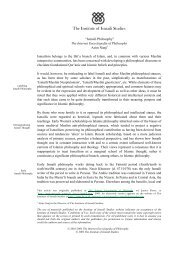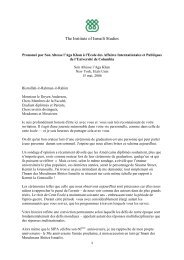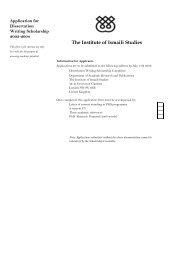BM-IIS Conference Pack.qxp - The Institute of Ismaili Studies
BM-IIS Conference Pack.qxp - The Institute of Ismaili Studies
BM-IIS Conference Pack.qxp - The Institute of Ismaili Studies
You also want an ePaper? Increase the reach of your titles
YUMPU automatically turns print PDFs into web optimized ePapers that Google loves.
<strong>BM</strong>-<strong>IIS</strong> <strong>Conference</strong> <strong>Pack</strong>.<strong>qxp</strong> 20/03/2009 14:12 Page 14<br />
cover a wide range <strong>of</strong> subjects including architecture, decorative arts, urbanism, waqf,<br />
the cultural history <strong>of</strong> Egypt and Syria, and aesthetics in the Arab world. Her books<br />
include: Egypt’s Adjustment to Ottoman Rule (Leiden, New York, Köln 1994); Beauty in<br />
Arabic Culture (Princeton 1999); and Cairo <strong>of</strong> the Mamluks (London 2007).<br />
YASSER TABBAA<br />
“Architecture for Piety: <strong>The</strong> Shi‘i Shrines <strong>of</strong> Syria”<br />
<strong>The</strong> dawn <strong>of</strong> the 21st century has witnessed the resurgence <strong>of</strong> political and cultural<br />
Shi‘ism and advanced the deeply rooted pluralism that lies at the foundation <strong>of</strong> Islam.<br />
Outmoded paradigms <strong>of</strong> essentialism or unity-within-diversity no longer suffice to<br />
explain the radically different forms presented by newly built Shi‘i shrines in Syria and<br />
elsewhere nor with the sheer volume <strong>of</strong> this discordant production. Viewing these<br />
developments instead from the perspective <strong>of</strong> difference and disjunction, this paper<br />
aims to explore the significance <strong>of</strong> these forms and the social and political implications<br />
<strong>of</strong> recent Shi‘i architecture in Syria.<br />
Yasser Tabbaa received his PhD in 1983 from the <strong>Institute</strong> <strong>of</strong> Fine Arts, New York<br />
University, where he specialised in Islamic art and architecture. In addition to his<br />
foundational work on the architecture <strong>of</strong> Nur al-Din, Tabbaa has published two books:<br />
Constructions <strong>of</strong> Power and Piety in Medieval Aleppo (University Park 1997) and <strong>The</strong><br />
Transformation <strong>of</strong> Islamic Art During the Sunni Revival (London and Seattle 2001, 2002), a<br />
book that places the radical transformations undergone by ornament and calligraphy<br />
in the 11th and 12th centuries within the context <strong>of</strong> contemporary theological and<br />
political controversies. Tabbaa has also published articles on the Islamic garden, Islamic<br />
calligraphy and epigraphy, the history <strong>of</strong> the Islamic hospital, and the newly built Shi‘i<br />
shrines in Syria. Yasser Tabbaa has taught Islamic art and history for more than 25 years<br />
in various American and Arab universities, including Oberlin College and the<br />
University <strong>of</strong> Michigan. He currently heads the department <strong>of</strong> Ethics, Philosophy and<br />
Religion at King’s Academy in Jordan, where he also teaches history and art history.<br />
STEPHENNIE MULDER<br />
Paper Abstracts and Academic Biographies<br />
“Shrines <strong>of</strong> the Prophet’s House: <strong>The</strong> Role <strong>of</strong> the ‘Alid Shrines in Medieval Syria’s<br />
Sacred Landscape”<br />
In medieval Syria (Bilad al-Sham), the Seljuk and Ayyubid periods are <strong>of</strong>ten<br />
characterised as an era <strong>of</strong> enmity toward Shi‘ism. However, new evidence suggests that<br />
frequently, an ongoing and complex inter-confessional negotiation took place. By the<br />
6th/12th century, the initial fervency <strong>of</strong> hostility toward Shi‘i communities had faded.<br />
Remaining antagonism from the Ayyubid and Seljuk rulers was directed largely toward<br />
Shi‘i groups that were perceived as ghulat or “heretical”, including the Isma‘ili Shi‘a,<br />
with the general acceptance <strong>of</strong> Imami (Twelver) Shi‘ism as a legitimate, if “misguided”,<br />
variation <strong>of</strong> Islamic practice. In Syria, Sunni rulers recognised the political perils <strong>of</strong><br />
openly antagonizing Shi‘i communities, which, according to the medieval traveler Ibn<br />
Jubayr, constituted the majority <strong>of</strong> Muslims in the Levantine coastal plain and cities like<br />
Aleppo and Homs. Even the great Sunni ruler Nur al-Din found himself required to<br />
moderate his policies, as he played a delicate game <strong>of</strong> political conciliation that<br />
included the patronage and upkeep <strong>of</strong> Shi‘i places <strong>of</strong> pilgrimage. All <strong>of</strong> this occurred<br />
during a period <strong>of</strong> great religious excitement, when the depredations <strong>of</strong> Crusader<br />
forces and the movement for the revival <strong>of</strong> Sunnism meant it was not uncommon for<br />
crowds <strong>of</strong> ordinary people to sleep in mosques in anticipation <strong>of</strong> hearing a particularly<br />
popular preacher. Against this vibrant backdrop, Syria became the stage for a pr<strong>of</strong>ound<br />
and systematic alteration <strong>of</strong> its sacred landscape. Long home to Biblical holy sites, Bilad<br />
al-Sham was now transformed into a holy land specific to Muslims, with the foundation<br />
<strong>of</strong> hundreds <strong>of</strong> shrines and sanctuaries, devoted to a dizzying array <strong>of</strong> Islamic holy<br />
figures. A key role in the generation <strong>of</strong> this landscape was played by the patronage <strong>of</strong><br />
shrines devoted to the ‘Alids, or descendents <strong>of</strong> ‘Ali. <strong>The</strong>se shrines – revered nearly<br />
exclusively by Muslims and sacred to both Sunni and Shi‘i – were uniquely Islamic and<br />
pr<strong>of</strong>oundly unifying in a time <strong>of</strong> vibrant Sunni revival.



